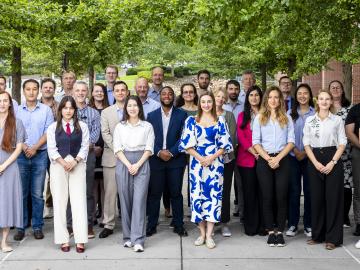
Filter News
Area of Research
News Type
News Topics
- (-) Clean Water (2)
- (-) Climate Change (13)
- (-) Education (2)
- (-) Machine Learning (7)
- (-) Summit (8)
- 3-D Printing/Advanced Manufacturing (16)
- Advanced Reactors (3)
- Artificial Intelligence (30)
- Big Data (11)
- Bioenergy (8)
- Biology (12)
- Biomedical (8)
- Biotechnology (6)
- Buildings (15)
- Chemical Sciences (17)
- Composites (7)
- Computer Science (26)
- Critical Materials (6)
- Decarbonization (18)
- Emergency (1)
- Energy Storage (8)
- Environment (16)
- Exascale Computing (12)
- Fossil Energy (2)
- Frontier (10)
- Fusion (9)
- Grid (9)
- High-Performance Computing (21)
- Isotopes (14)
- Materials (16)
- Materials Science (19)
- Mathematics (3)
- Microelectronics (2)
- Microscopy (2)
- Molten Salt (1)
- Nanotechnology (1)
- National Security (23)
- Net Zero (4)
- Neutron Science (15)
- Nuclear Energy (10)
- Partnerships (19)
- Physics (7)
- Polymers (2)
- Quantum Computing (13)
- Quantum Science (15)
- Security (4)
- Simulation (14)
- Space Exploration (3)
- Statistics (2)
- Sustainable Energy (15)
- Transportation (6)
Media Contacts

The Oak Ridge Leadership Computing Facility welcomed users to an interactive meeting at the Department of Energy’s Oak Ridge National Laboratory from Sept. 10–11 for an opportunity to share achievements from the OLCF’s user programs and highlight requirements for the future.

The Summit supercomputer, once the world’s most powerful, is set to be decommissioned by the end of 2024 to make way for the next-generation supercomputer. Over the summer, crews began dismantling Summit’s Alpine storage system, shredding over 40,000 hard drives with the help of ShredPro Secure, a local East Tennessee business. This partnership not only reduced costs and sped up the process but also established a more efficient and secure method for decommissioning large-scale computing systems in the future.

Three flights, five thousand miles and half a dozen clearances and permissions stood between Tetiana Maltseva and the Department of Energy’s Oak Ridge National Laboratory. When she finally arrived at the lab to represent Ukraine at the 2024 Nuclear Energy Management School, her vision was clear.

As a mechanical engineer in building envelope materials research at ORNL, Bryan Maldonado sees opportunities to apply his scientific expertise virtually everywhere he goes, from coast to coast. As an expert in understanding how complex systems operate, he’s using machine learning methods to control the process and ultimately optimize performance.

ORNL’s Joshua New was named the 2024 Researcher of the Year by R&D World magazine as part of its R&D 100 Professional Award winners.

Debjani Singh, a senior scientist at ORNL, leads the HydroSource project, which enhances hydropower research by making water data more accessible and useful. With a background in water resources, data science, and earth science, Singh applies innovative tools like AI to advance research. Her career, shaped by her early exposure to science in India, focuses on bridging research with practical applications.

A study found that beaches with manmade fortifications recover more slowly from hurricanes than natural beaches, losing more sand and vegetation. The researchers used satellite images and light detection and ranging data, or LIDAR, to measure elevation changes and vegetation coverage. Changes in elevation showed how much sand was depleted during the storm and how much sand returned throughout the following year.

The world’s fastest supercomputer helped researchers simulate synthesizing a material harder and tougher than a diamond — or any other substance on Earth. The study used Frontier to predict the likeliest strategy to synthesize such a material, thought to exist so far only within the interiors of giant exoplanets, or planets beyond our solar system.
The contract will be awarded to develop the newest high-performance computing system at the Oak Ridge Leadership Computing Facility.

To better predict long-term flooding risk, scientists at the Department of Energy’s Oak Ridge National Laboratory developed a 3D modeling framework that captures the complex dynamics of water as it flows across the landscape. The framework seeks to provide valuable insights into which communities are most vulnerable as the climate changes, and was developed for a project that’s assessing climate risk and mitigation pathways for an urban area along the Southeast Texas coast.


